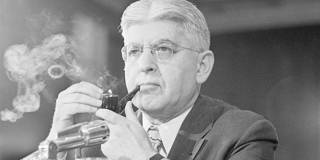The US Federal Reserve is insisting that recent increases in the price of food, construction materials, used cars, personal health products, gasoline, and appliances reflect transitory factors that will quickly fade with post-pandemic normalization. But what if they are a harbinger, not a "noisy" deviation?
NEW HAVEN – Memories can be tricky. I have long been haunted by the inflation of the 1970s. Fifty years ago, when I had just started my career as a professional economist at the Federal Reserve, I was witness to the birth of the Great Inflation as a Fed insider. That left me with the recurring nightmares of a financial post-traumatic stress disorder. The bad dreams are back.
They center on the Fed’s legendary chairman at the time, Arthur F. Burns, who brought a unique perspective to the US central bank as an expert on the business cycle. In 1946, he co-authored the definitive treatise on the seemingly rhythmic ups and downs of the US economy back to the mid-nineteenth century. Working for him was intimidating, especially for someone in my position. I had been tasked with formal weekly briefings on the very subjects Burns knew best. He used that knowledge to poke holes in staff presentations. I found quickly that you couldn’t tell him anything.
Yet Burns, who ruled the Fed with an iron fist, lacked an analytical framework to assess the interplay between the real economy and inflation, and how that relationship was connected to monetary policy. As a data junkie, he was prone to segment the problems he faced as a policymaker, especially the emergence of what would soon become the Great Inflation. Like business cycles, he believed price trends were heavily influenced by idiosyncratic, or exogenous, factors – “noise” that had nothing to do with monetary policy.

NEW HAVEN – Memories can be tricky. I have long been haunted by the inflation of the 1970s. Fifty years ago, when I had just started my career as a professional economist at the Federal Reserve, I was witness to the birth of the Great Inflation as a Fed insider. That left me with the recurring nightmares of a financial post-traumatic stress disorder. The bad dreams are back.
They center on the Fed’s legendary chairman at the time, Arthur F. Burns, who brought a unique perspective to the US central bank as an expert on the business cycle. In 1946, he co-authored the definitive treatise on the seemingly rhythmic ups and downs of the US economy back to the mid-nineteenth century. Working for him was intimidating, especially for someone in my position. I had been tasked with formal weekly briefings on the very subjects Burns knew best. He used that knowledge to poke holes in staff presentations. I found quickly that you couldn’t tell him anything.
Yet Burns, who ruled the Fed with an iron fist, lacked an analytical framework to assess the interplay between the real economy and inflation, and how that relationship was connected to monetary policy. As a data junkie, he was prone to segment the problems he faced as a policymaker, especially the emergence of what would soon become the Great Inflation. Like business cycles, he believed price trends were heavily influenced by idiosyncratic, or exogenous, factors – “noise” that had nothing to do with monetary policy.